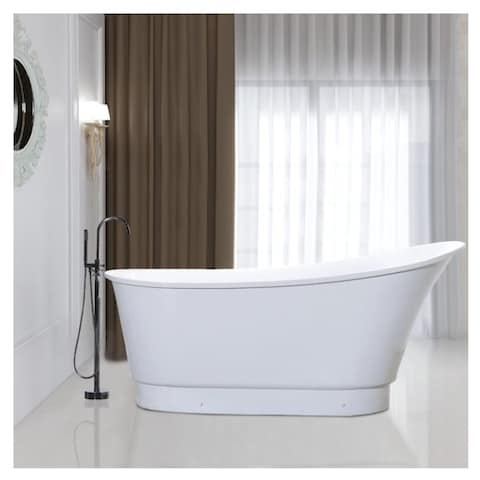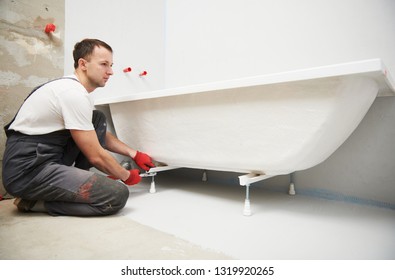Just about every person will have his or her own theory in relation to A Step-by-Step Guide to Installing a Bathtub.

Setting up a bathtub isn't precisely brain surgery, but it does call for strong plumbing, carpentry, and also sometimes, tiling skills. Changing an old bathtub with a new one is additionally a moderately challenging job. If the old bathtub is easily obtainable, the project can relocate quickly; if you have to open up a wall to eliminate the old bathtub and also position the brand-new bath tub, the task is much harder. In either situation, the task is within a home handyman's skills, although you will certainly require an assistant to vacate the old tub and set in the brand-new one. Make sure you have actually qualified yourself for the job and are comfortable attempting it. Rather than hiring a professional to take over a halfway-completed job, it is much better to think about utilizing one before you begin. Possibilities are you may need a professional plumber to make tube connections.
This short article will assist you set up a brand-new tub in your shower room if you have actually already bought a new tub and do not require to alter the setup of your previous water pipelines.
Your tools as well as material list need to comprise the following:
Removing Old Touches
If you require to replace old faucets with new ones as a part of your installation, after that the first thing you must do is disconnect the water supply. After doing so, activate the faucets to drain any kind of water staying in the system. The process of getting rid of the existing taps can be quite bothersome because of the limited gain access to that is typically the case.
Make use of a container wrench (crowsfoot spanner) or a tap tool to reverse the nut that links the supply pipelines to the faucets. Have a towel ready for the remaining water that will certainly come from the pipelines. When the supply pipes have actually been eliminated, utilize the same device to loosen the nut that holds the taps onto the bath/basin. You will require to stop the solitary faucets from turning during this process. As soon as the taps have actually been removed, the holes in the bath/basin will need to be cleaned of any type of old sealing substance.
Before going on to fit the brand-new taps, compare the pipe links on the old taps to the brand-new taps. If the old faucets are longer than the new faucets, after that a shank adapter is required for the brand-new taps to fit.
Suitable New Taps
If the tails of the brand-new faucets are plastic, then you will certainly need a plastic port to stop damage to the string. One end of the port fits on the plastic tail of the faucet and also the other end gives a link to the existing supply pipes.
If you require to fit a monobloc, after that you will require lowering couplers, which links the 10mm pipe of the monobloc to the standard 15mm supply pipeline.
Next, place the faucet in the mounting opening in the bath/basin making sure that the washers remain in area in between the tap and also the sink. Secure the tap in position with the maker supplied backnut. Once the faucet is firmly in position, the supply pipes can be connected to the tails of the faucets. The faucets can either be linked by utilizing corrugated copper piping or with regular tap connectors. The previous kind must be connected to the faucet ends initially, tightening just by hand. The supply pipes can later on be linked to the various other end. Tighten up both ends with a spanner after both ends have been connected.
Mounting the Tub
Using both wooden boards under its feet, position the bath tub in the needed position. The wood boards are handy in uniformly spreading the weight of the bath tub over the area of the boards rather than focusing all the weight onto 4 small factors.
The next objective is to make sure that the bathtub is leveled all round. This can be attained by checking the spirit level and readjusting the feet on the bath tub until the level reviews level.
To install faucets, fit the bottom of the furthest adaptable tap port to the ideal supply pipe by making a compression join; then do the same for the other faucet.
Turn on the supply of water and examine all joints as well as new pipework for leaks and also tighten them if necessary. Fill the bath tub and also check the overflow electrical outlet and the regular outlet for leakages.
Finally, deal with the bath paneling as described in the maker's instruction manual. Tiling and also sealing around the tub ought to wait until the tub has been made use of at least when as this will resolve it into its last position.
Getting ready for the Setup
To start with, the supporting frame provided with the bath must be fitted (if called for) according to the manufacturer's directions. Next off, fit the faucets or mixer to the bathtub. When fitting the faucet block, it is important to ensure that if the faucet features a plastic washer, it is fitted between the bath as well as the faucets. On a plastic bathroom, it is also sensible to fit a supporting plate under the faucets device to stop pressure on the bathtub.
Fit the adaptable faucet connectors to the bottom of the two taps using 2 nuts as well as olives (in some cases provided with the tub). Fit the plug-hole outlet by smearing mastic filler round the sink outlet hole, and after that pass the outlet through the hole in the bath. Use the nut supplied by the manufacturer to fit the plug-hole. Analyze the plug-hole electrical outlet for an inlet on the side for the overflow pipeline.
Next, fit the end of the flexible overflow pipe to the overflow outlet. After that, screw the pipeline to the overflow face which must be fitted inside the bath. See to it you make use of every one of the provided washing machines.
Attach the catch to the bottom of the waste electrical outlet on the tub by winding the thread of the waste outlet with silicone mastic or PTFE tape, and screw on the trap to the electrical outlet. Attach all-time low of the overflow tube in a comparable manner.The bath need to currently be ready to be suited its final position.
Tiling Around the Bath tub
In the location where the bath fulfills the ceramic tile, it is necessary to secure the accompanies a silicone rubber caulking. This is very important as the installation can move enough to crack an inflexible seal, triggering the water to penetrate the wall between the bath and the tiling, resulting in complications with moisture and also feasible leakages to the ceiling below.
You can select from a variety of coloured sealers to assimilate your fixtures and also fittings. They are marketed in tubes as well as cartridges, and can sealing voids as much as a width of 3mm (1/8 inch). If you have a bigger space to load, you can fill it with spins of soaked paper or soft rope. Remember to constantly fill the tub with water prior to sealing, to permit the movement experienced when the bathtub is in use. The sealant can break rather very early if you do not think about this motion before sealing.
Conversely, ceramic coving or quadrant ceramic tiles can be used to edge the bathroom or shower tray. Plastic strips of coving, which are easy to use and reduce to dimension, are likewise conveniently available on the market. It is a good idea to fit the floor tiles using water-resistant or water resistant glue and grout.
Bathtub Installation
How Important Is A Bathtub To Your Home?
High-quality baths, showers, and other bathroom updates are necessary when considering a smart investment in your home. It’s a room that you go to every day and one that is constantly being used by guests.The bathroom is one of the top trafficked rooms in a home and also one of the most valuable in terms of home resale.
Install Piping Before Tub
You will be using your existing drain and waste vent system, but pipes required include the hot and cold water supply lines and a pipe leading to a shower head. A mixing valve and shower head are also needed. Air chambers may be required.
Position the Tub
Lower the tub into place so that the continuous flange fits against the wall studs and rests on 1’x4' or 2’x4' supports. Anchor the tub to the enclosure with nails or screws inserted through the flanges into the studs.
NOTE: Remember, bathtubs and shower stalls may require support framing. A bathtub filled with water is extremely heavy, so check building codes and framing support before installing the tub.
Assemble Drain Connections
Assemble the bathtub drain connections by connecting the tub overflow with the tub drain above the trap, not beyond it. The trap will have a compression fitting that screws over the arm of the overflow assembly.
Place a Pipe For the Shower Head
First, locate a brass female threaded winged fitting and attach it to a framing support via a screw or a nail. Then run a pipe up the wall for the shower head. Sweat or solder the other side of the brass fitting to the top of the pipe.
Attaching Hot and Cold Water Lines
Attach your water lines for both hot and cold by sweating these directly into the hot and cold ports of the mixing valve. The mixing valve will be how water enters the tub’s system, not by the pipes themselves.
Install the Spout
Extend a piece of 1/2 inch pipe, or whichever length is specified in the manufacturer’s instructions, for the tub spout. Sweat on a male threaded fitting at the end of the pipe or use a brass nipple of the proper length and a 1/2 inch cap.
NOTE: At this point you should have your rough-in plumbing work inspected before proceeding further.
Check For Leaks
Restore the water pressure and check the drain connection and the supply pipes for any sign of leaking.
estore the Bathroom Wall
Replace the wall with moisture-resistant drywall as a base for your wall covering. Seal the joints between the wall and your new tub with silicone caulk as protection against water seepage.
https://www.berkeys.com/2016/12/02/bathtub-installation-dallas/

As an enthusiastic person who reads about Tools You Need to Install a New Bathtub , I assumed sharing that article post was a smart idea. So long as you enjoyed reading our page please be sure to share it. Thank-you for taking the time to read it.
Source This Article